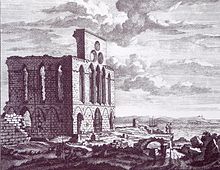Church of Saint Andrew, Acre
| St. Andrew's Church | |
|---|---|
| כנסיית אנדראס הקדוש | |
Catholic (Greek-Catholic Eastern Rite) |
St Andrew's Church is a
History

St. Andrew's Church (
The Crusaders of the Templars order settled in Acre in the 12th century, after the fall of Jerusalem, and built a fortress on the south-west corner of the old city of Acre. Adjacent to their palace (Templum) they built the Church of Santa Anna, named after the Mother of the Virgin Mary. The 12th-century church was rebuilt and enlarged in the 13th century as a grand Gothic Cathedral. The structure of the two-story Crusader church survived and stone of the original church was used in the construction of the current building. The top floor of the original Crusader church remains and is still in ruins.
In 1291 the city was
The Greek Catholic church (Melkites) split from the Greek Orthodox church in 1724. In 1765, the church was rebuilt over the ruins of the medieval church. A sign near above the door near the entrance to the church shows the year of 1802, when the Greek Catholic Archbishopric was founded at the church. It later moved to Haifa.[11]
Present day
The church of St. Andrew is open to the public, and serves the Greek Catholic Melkite community. On the west side of the church, facing the sea, is a small courtyard. Embedded into the wall is a segment of a head of an ancient statue, possibly one of John the Baptist, which belonged to the older Crusader church. The modern church has an ornate Templon, decorated with icons and paintings, which separates the nave and the altar, or sanctuary. The icons are of Christ, the Virgin Mary, Apostles, John the Baptist, Saints and the prophet Elijah. The names above each icon are written in Arabic, and were crafted in Syria.[12]
See also
- Roman Catholicism in Israel
- Melkite Greek Catholic Archeparchy of Akka
References
- ^ "Old Acre - San Andreas Church". www.akko.org.il. Retrieved 2016-10-14.
- ^ "The Churches of Acre - Bein Harim Tours - Blog". Bein Harim Tours - Blog. 2014-12-11. Retrieved 2016-10-14.
- ^ Al-Maqrizi. Madrasa of Al-Nasir Muhammad. Trans. Martyn Smith. [1]. Pub 2009. Accessed 8 March 2011
- ISBN 978-90-04-25815-0.
- ^ Mayer, Wolgang (2007). "The Madrasa of Sultan al-Nasir Muhammad: the Portal". In Mayer, Wolfgang; Speiser, Philipp (eds.). A future for the past: restorations in Islamic Cairo 1973-2004. Mainz: Verlag Philipp Von Zabern. pp. 95–98.
- ^ Behren-Abouseif, Doris (2007). Cairo of the Mamluks: A History of its Architecture and its Culture. I. B. Tauris & Co Ltd. pp. 152–156.
- ISBN 978-0-8018-7823-7.
- ISBN 978-1-78969-328-7.
- ISBN 978-1-899828-04-3.
- ^ "Acre: St. Andrews Church". www.biblewalks.com. Retrieved 2016-10-14.
- ISBN 9780521835831.
- ^ "Acre: St. Andrews Church". www.biblewalks.com. Retrieved 2016-10-14.
